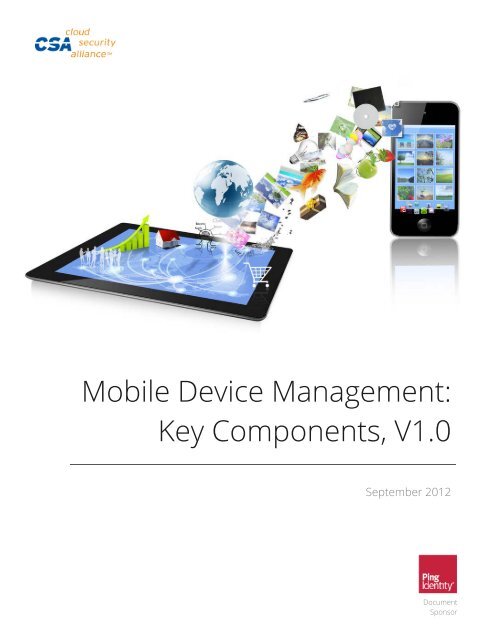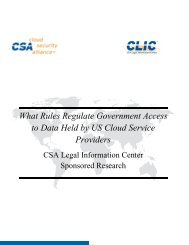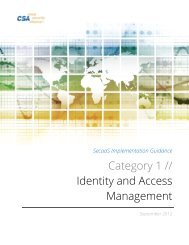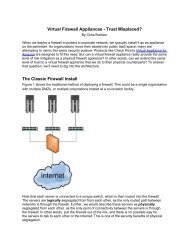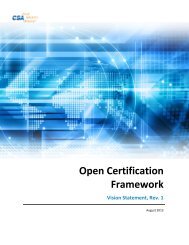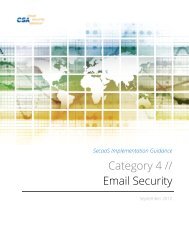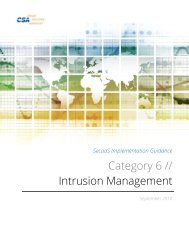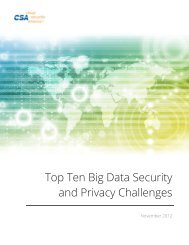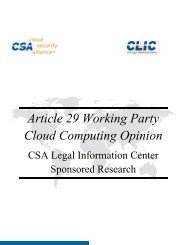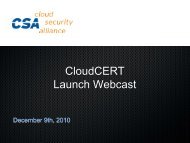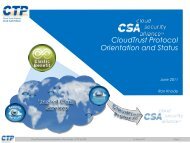Mobile Device Management: Key Components, V1.0
Mobile Device Management: Key Components, V1.0
Mobile Device Management: Key Components, V1.0
- No tags were found...
Create successful ePaper yourself
Turn your PDF publications into a flip-book with our unique Google optimized e-Paper software.
<strong>Mobile</strong> <strong>Device</strong> <strong>Management</strong>:<strong>Key</strong> <strong>Components</strong>, <strong>V1.0</strong>September 2012DocumentSponsor
CLOUD SECURITY ALLIANCE <strong>Mobile</strong> <strong>Device</strong> <strong>Management</strong>: <strong>Key</strong> <strong>Components</strong>, <strong>V1.0</strong>, September 2012© 2012 Cloud Security AllianceAll rights reserved. You may download, store, display on your computer, view, print, and link to the CloudSecurity Alliance <strong>Mobile</strong> <strong>Device</strong> <strong>Management</strong> <strong>Key</strong> <strong>Components</strong> at http://www.cloudsecurityalliance.org, subjectto the following: (a) the Document may be used solely for your personal, informational, non-commercial use; (b)the Document may not be modified or altered in any way; (c) the Document may not be redistributed; and (d)the trademark, copyright or other notices may not be removed. You may quote portions of the Document aspermitted by the Fair Use provisions of the United States Copyright Act, provided that you attribute the portionsto the Cloud Security Alliance <strong>Mobile</strong> <strong>Device</strong> <strong>Management</strong> <strong>Key</strong> <strong>Components</strong> (2012).© Copyright 2012, Cloud Security Alliance. All rights reserved. 1
CLOUD SECURITY ALLIANCE <strong>Mobile</strong> <strong>Device</strong> <strong>Management</strong>: <strong>Key</strong> <strong>Components</strong>, <strong>V1.0</strong>, September 2012ContentsAcknowledgments ......................................................................................................................................................3SECTION 1: Introduction and Context ........................................................................................................................4SECTION 2: MDM <strong>Key</strong> <strong>Components</strong> to Consider in Both Scenarios – BYOD or Company-Owned <strong>Device</strong>s ...............52.1 Policy ............................................................................................................................................................52.2 Risk <strong>Management</strong> .........................................................................................................................................62.3 <strong>Device</strong> Diversity / Degree of Freedom .........................................................................................................62.4 Configuration <strong>Management</strong> .........................................................................................................................62.5 Software Distribution ...................................................................................................................................62.6 Enterprise AppStore .....................................................................................................................................72.7 Content Library .............................................................................................................................................72.8 Procurement .................................................................................................................................................72.9 Provisioning ..................................................................................................................................................72.10 <strong>Device</strong> Policy Compliance & Enforcement .................................................................................................82.11 Enterprise Activation / Deactivation ..........................................................................................................82.12 Enterprise Asset Disposition .......................................................................................................................82.13 Process Automation ...................................................................................................................................82.14 User Activity Logging / Workplace Monitoring ..........................................................................................92.15 Security Settings .........................................................................................................................................92.16 Selective Wipe / Remote Wipe / Lock ........................................................................................................92.17 Identity <strong>Management</strong> / Authentication / Encryption ................................................................................9SECTION 3: CONCLUSION ........................................................................................................................................ 11© Copyright 2012, Cloud Security Alliance. All rights reserved. 2
CLOUD SECURITY ALLIANCE <strong>Mobile</strong> <strong>Device</strong> <strong>Management</strong>: <strong>Key</strong> <strong>Components</strong>, <strong>V1.0</strong>, September 2012AcknowledgmentsCSA <strong>Mobile</strong> Working Group Co-ChairsDavid Lingenfelter, FiberlinkFreddy Kasprzykowski, MicrosoftCesare Garlati, Trend MicroInitiative LeadGuido Sanchidrian, SymantecContributorsJane Cosnowsky, DellSam WilkeAllen Lum, Control SolutionsJay Musterman, Cox CommunicationsSomanath NG, InfosysEiji Sasahara, IDCAlice Decker, Trend MicroPamela Fusco, Virtuosi GroupNader Henein, Research In MotionPaul Madsen, Ping IdentityTyler Shields, VeracodeSubbu Iyer, ZscalerCSA Global StaffAaron Alva, Graduate Research InternLuciano JR Santos, Research DirectorEvan Scoboria, WebmasterKendall Scoboria, Graphic DesignerJohn Yeoh, Research Analyst© Copyright 2012, Cloud Security Alliance. All rights reserved. 3
CLOUD SECURITY ALLIANCE <strong>Mobile</strong> <strong>Device</strong> <strong>Management</strong>: <strong>Key</strong> <strong>Components</strong>, <strong>V1.0</strong>, September 2012SECTION 1: Introduction and ContextWith the growth in the number of applications, content, and data being accessed through a variety of devices,<strong>Mobile</strong> <strong>Device</strong> <strong>Management</strong> (MDM) is vital to managing the mobile enterprise. MDM is about much more thandevice management alone—it includes system-centric functionality to secure and manage data and applications,as well as information-centric functionality such as the delivery of the enterprise application store or contentlibrary.PlanningRetirement /ReplacementHardwareSoftwareServiceAcquisition<strong>Management</strong>DeploymentMDM is a critical component of the device lifecycle, covering the device hardware, software, and attachedservices.Full lifecycle management is required, and IT is fully responsible for the company-owned devices, includingsetting hardware/OS standards, application support and enterprise liability. However, organizations mightchoose a “degree of freedom” for their users, such as increased hardware and OS choices by Bring-Your-Own-<strong>Device</strong> (BYOD) support, or might provide limited capabilities such as corporate email or web services only. Bothwill create shared responsibilities and a mix of enterprise and user liabilities that should be properly defined,communicated, and managed.© Copyright 2012, Cloud Security Alliance. All rights reserved. 4
CLOUD SECURITY ALLIANCE <strong>Mobile</strong> <strong>Device</strong> <strong>Management</strong>: <strong>Key</strong> <strong>Components</strong>, <strong>V1.0</strong>, September 2012SECTION 2: MDM <strong>Key</strong> <strong>Components</strong> to Consider inBoth Scenarios – BYOD or Company-Owned<strong>Device</strong>sSoftware andHardware•<strong>Device</strong> Diversity / Degreeof Freedom•Configuration<strong>Management</strong>•Software Distribution• Backup / Restore• Patches / Fixes• Updates• Synchronization•Enterprise AppStore•Content LibraryInventory•Procurement•Provisioning•<strong>Device</strong> Policy Compliance& Enforcement•Enterprise Activation /Deactivation•Enterprise AssestDisposition•Process Automation•User Activity Logging /Workplace MonitoringSecurity•Security Settings•Selectivve Wipe / RemoteWipe / Lock•Identity <strong>Management</strong> /Authentication /EncryptionPolicy / Risk <strong>Management</strong>2.1 Policy Rating 1 : Must HaveThe definition and distribution of a policy is a critical prerequisite of mobile computing strategies. Organizationsshould assess the needs of the workforce and build or revise the mobile policy accordingly. Risk assessment andmanagement should be performed to recognize the significance of IT and information risk, which both defines abasis for developing awareness and enables analysis of the business risk impact. A well-defined policy providesmanagement direction and support for IT and information security and is the foundation for a solid MDMframework implementation.1 The initial rating is based on common importance and risk level of each component. Depending on organizations individual riskassessment results, the rating might change dynamically case-by-case.© Copyright 2012, Cloud Security Alliance. All rights reserved. 5
CLOUD SECURITY ALLIANCE <strong>Mobile</strong> <strong>Device</strong> <strong>Management</strong>: <strong>Key</strong> <strong>Components</strong>, <strong>V1.0</strong>, September 20122.2 Risk <strong>Management</strong> Rating: Must HaveRisk management means the entire process of analysis, planning, implementation, control, and monitoring ofdefined measurements and the enforced policy. Organizations should consider the impact of the introduction ofmobile devices as end-point devices within their corporate network. If risks are identified, the appropriatemobile device policies can be applied. In an extreme case, if the risk is deemed too high, additional controlsshould be implemented to bring the risk to an acceptable level, allowing seamless access to IT resources frommobile devices. On the other hand, if the risk is low or non-existent, the organization can require minimalcontrols for the mobile devices, thereby reducing overall costs.As part of risk management, organizations should perform risk assessment periodically (i.e. once a year) or ondemand(i.e. introducing new devices, services, or significant infrastructure changes) to provide a temporaryview of assessed risks and to review the risk management process, either in parts or entirely, and makenecessary changes accordingly. 22.3 <strong>Device</strong> Diversity / Degree of Freedom Rating: OptionalBoth scenarios—BYOD and company-owned devices—require segmentation and acceptable usage planning builton a multi-dimensional matrix, which includes the user’s role, responsibility (including ownership and support),data, networks and applications, and which states the user’s degree of freedom for each area. This planningalso defines the capabilities provided, such as corporate email, web services, support, multimedia, specializedapplications and services, corporate databases such as CRM, and analytics.2.4 Configuration <strong>Management</strong> Rating: Must HaveConfiguration management involves automated configuration of device settings, such as password strength andpolicy, email, VPN and Wi-Fi. Configuration management aids in the elimination of user errors and minimizesvulnerabilities caused by misconfiguration, including configuration lockdown according to a degree-of-freedomdefinition, as well as hardware lockdown such as camera, Bluetooth, and Wi-Fi. Configuration management isalso used in an effort to enforce corporate IT mobility policies.2.5 Software Distribution Rating: Must HaveSoftware distribution includes applications and software accessed over-the-air or by PC synchronization. Itincludes updates for applications or OSs, patches, fixes, backup and restore functionality, backgroundsynchronization, and basic file distribution capabilities. Backup and restore functionality accessed over-the-air orvia PC-sync in particular becomes important in situations of device crash and replacements, intentional wipeout(i.e. in case of lost or stolen device) or unintentional wipeout (i.e. kids play with device and try password toooften), so the device can be recovered quickly without significant productivity loss. Aligned to the corporatemobile policies it ensures the distribution of only security assessed mobile applications to the device. Along with2 Visit European Network and Security Agency (ENISA) website at http://www.enisa.europa.eu/activities/risk-management/currentrisk/risk-management-inventory/rm-ismsfor an introduction on Risk <strong>Management</strong> and Risk Assessment.© Copyright 2012, Cloud Security Alliance. All rights reserved. 6
CLOUD SECURITY ALLIANCE <strong>Mobile</strong> <strong>Device</strong> <strong>Management</strong>: <strong>Key</strong> <strong>Components</strong>, <strong>V1.0</strong>, September 2012Configuration <strong>Management</strong>, software distribution helps to enforce the corporate approach of black-listingand/or white-listing applications and other software on the device. <strong>Mobile</strong> <strong>Device</strong> <strong>Management</strong> systemsgenerally do not have a capability to analyze mobile applications for security risk. The analysis of theseapplications should be conducted separately in order to populate the white-list and black-list approaches withactionable application security assessments.2.6 Enterprise AppStore Rating: OptionalAn Enterprise AppStore ensures that only secure and trusted applications along with associated content will bedeployed on mobile devices while providing several paths of accessibility: through deployment of mobileapplications over-the-air, recommended apps from the public AppStore, or via a company-specific apprepository. AppStores include appropriate code-signing of specialized or in-house applications to ensure theintegrity of the application. Enterprise AppStores provide an excellent environment in the corporate mobileecosystem to implement security testing and application whitelisting.2.7 Content Library Rating: OptionalA content library distributes corporate content, such as documents and multi-media videos, to provide a secureenterprise container with near-real-time updates and specific views. The library may include the secure usage ofCloud storage providers, or sandbox/virtualized environments to separate corporate content from privatecontent. In the case of different containers it may be necessary to control applications and informationdifferently with different policies depending on whether they or corporate or personal apps and information.2.8 Procurement Rating: Must HaveWith devices evolving into application development and integration platforms, IT is likely taking ownership ofthe end-to-end solution by contracting wireless carriers and programs and managing service usage. However,the finance department maintains responsibility for monitoring and controlling mobility costs, such as contractand expense management. It is important to collaborate and align with Legal and HR departments to definecertain terms and conditions in the policy and employee agreements. In particular, BYOD creates a mix ofcorporate and personal liability and responsibility. Liability for all parties should be clearly defined in theseagreements and should include subjects such as private usage of corporate services, expense compensations,employee privacy policy, shared responsibilities for device and content security, misuse, secure wipe of thedevice including personal data in the event the device is lost or stolen, or the rights to control the devicethrough a device management client.2.9 Provisioning Rating: OptionalProvisioning devices with a three year refresh is acceptable for company-owned devices, but IT cannot possiblymanage employee-liable devices that are refreshed annually (or in even shorter cycles for smartphones andtablets). Expectations about end-user support should be clear and frequently refreshed, as self-help is often notaccepted by some users, in particular those with brand new devices.© Copyright 2012, Cloud Security Alliance. All rights reserved. 7
CLOUD SECURITY ALLIANCE <strong>Mobile</strong> <strong>Device</strong> <strong>Management</strong>: <strong>Key</strong> <strong>Components</strong>, <strong>V1.0</strong>, September 20122.10 <strong>Device</strong> Policy Compliance & Enforcement Rating: Must Have<strong>Device</strong> policy compliance and enforcement is involved in device supply, control, and tracking. Asset inventoryassessments are critical prerequisites for policy enforcement to comply with corporate and regulatoryrequirements around policies, encryption, jail-broken or rooted-device detection, and privacy-related separationof personal content vs. corporate content. Compliance and enforcement also includes approval and reviewprocesses of apps in the organization’s AppStore, as well as approval of mobile configurations to ensure thatthey meet the organization’s security policies before roll out. The organization will allow or deny access todevices based on their approval status. This is an ongoing monitoring and enforcement process, often describedas Plan-Do-Check-Act approach of policies in various Information Security <strong>Management</strong> System standards andframeworks such as ISO 27001 or COBIT. It also requires alerts and notifications capabilities to provide assetreporting about devices, users, and apps. As part of the organizational infrastructure change control or similarprocesses, it is highly recommended to document that the policy and standard has been applied to the deviceand has been acknowledged by the user before the device is distributed.2.11 Enterprise Activation / Deactivation Rating: Must HaveEnterprise activation or deactivation is usually a self-service functionality that activates or connects mobiledevices to the enterprise network, or that allows or denies access to users based on directory groups. A properimplementation of it (in particular an implementation as a self-service) will reduce the administrative burden ofprovisioning and re-provisioning at the IT department. User acceptance is an important factor of it and shouldbe clarified and well communicated in the beginning. In particular in environments where users bring in theirown devices, choosing enterprise activation will likely share certain details like operating system, deviceidentifier, IMEI number, etc. as part of the provision process. The process can be either automated through aprovisioning portal to enter the required details and follow the workflow to activate the device, or it can be amanual process where the administrator will do the complete activation by taking the required details from theuser. In addition, after enterprise activation some characteristics of the device may be changed like enabledencryption, changed password settings, certain application restrictions, etc.2.12 Enterprise Asset Disposition Rating: Must HaveEnterprise asset disposition involves removal of physical devices by decommission or by releasing the device tothe BYOD owner in case of device exchange, upgrade, or permanent decommissioning. Appropriate technicaland procedural controls should be in place on inventory management, user receipts or acknowledgements, andrelated physical actions required for proper handling during decommissioning. It is important to securely wipethe corporate data from a personal device before it is decommissioned. If the device itself is not owned byenterprise, it should be handed over to the device owner ideally without touching the personal data, music, andapps.2.13 Process Automation Rating: OptionalProcess automation creates and implements automated processes that link together people, processes, andtechnology. It automates regular tasks like device registration and lost devices (i.e. if a device is lost or stolen,© Copyright 2012, Cloud Security Alliance. All rights reserved. 8
CLOUD SECURITY ALLIANCE <strong>Mobile</strong> <strong>Device</strong> <strong>Management</strong>: <strong>Key</strong> <strong>Components</strong>, <strong>V1.0</strong>, September 2012an automated workflow should be initiated that remotely wipes the device and revokes particular access rights.Then, a new device should be provisioned, with appropriate pre-load and configuration prior delivery to theuser). Process automation also includes technical tasks such as backup restore, as well as procedural taskswhere human attestation is required (i.e. management sign-off for the order).2.14 User Activity Logging / Workplace Monitoring Rating: Must HaveMore and more organizations are turning to workplace monitoring 3 and data loss prevention (DLP) technology.Workplace monitoring is usually governed by a variety of privacy laws, rules, and regulations. In some countries,the laws on telecommunications regulate the monitoring of email and other electronic communications. Inother countries, an employer’s rights to monitor employee communications may be governed by collectivebargaining agreements, employment contracts, or general privacy and data protection legislation. It isimportant to understand that privacy is treated as a fundamental human right and, as such, cannot be bargainedaway. This becomes more complex with environments with both corporate supplied and BYOD devices wherelaws and regulations are significantly different. Organizations are highly recommended to seek legal counsel tounderstand the privacy and data protection laws of the individual countries in which they operate.2.15 Security Settings Rating: Must HaveAccording to company policy, security settings provide advanced security on devices irrespective of ownership.They set, deploy, and update settings like passwords, wipe, and application/resource restrictions, usuallywithout any user intervention. Security can be broken into two basic components; user security and datasecurity. While user and data security are tightly coupled there are some distinct differences which must beaccounted for and sometimes handled quite differently. In both cases companies must take steps to protectthe user and the data from potential threats.2.16 Selective Wipe / Remote Wipe / Lock Rating: Must HaveSelective wipe securely wipes the corporate data from a personal device, without touching the personal data,music, and apps. It will also delete documents from the user’s Content Library. If a device is lost or stolen, aremote wipe must be performed by either the administrator or the end user. The remote wipe will, in effect,wipe all information from the device returning it to factory default configuration. Similarly a Lock can beperformed on a device by the administrator or end user to ensure that protection is in place should the devicebecome temporarily misplaced. If the wrong password is entered multiple times, an automatic wipe will betriggered.2.17 Identity <strong>Management</strong> / Authentication / Encryption Rating: Must HaveIdentity management, authentication, and encryption involved management of strong encryption of local data(device memory, external memory cards) and data in motion (such as email S/MIME encryption and3 The term “monitoring” is used broadly to refer to any reading, collection, or storage of electronic communications. Monitoring is,therefore, more than the interception of communications in transit. Copying of employee emails for backups or scanning messages todetect viruses are both considered to be monitoring.© Copyright 2012, Cloud Security Alliance. All rights reserved. 9
CLOUD SECURITY ALLIANCE <strong>Mobile</strong> <strong>Device</strong> <strong>Management</strong>: <strong>Key</strong> <strong>Components</strong>, <strong>V1.0</strong>, September 2012authentication). It requires certificate distribution capabilities and certificate-based authentication (includingdevice ID, OS version, phone number) to identify the device and user properly. Strong certificate-basedauthentication enables secure access to corporate email, web-based applications, VPN and Wi-Fi. It comesalong with overlaying identity management processes and mechanisms by which enterprise employees areissued accounts and credentials required to provide access to the device, the business applications and servicesbased on a context-aware policy that includes who they are, their role, their device, their network and theirinformation and application. It could also enables employees access to cloud applications and services onmobile devices via single sign-on credentials and identity brokering to authenticate to third-party SaaS.© Copyright 2012, Cloud Security Alliance. All rights reserved. 10
CLOUD SECURITY ALLIANCE <strong>Mobile</strong> <strong>Device</strong> <strong>Management</strong>: <strong>Key</strong> <strong>Components</strong>, <strong>V1.0</strong>, September 2012SECTION 3: CONCLUSIONTechnologyProcessPeople<strong>Mobile</strong> devices have quickly become a mainstay in enterprise environments, and while mobile devices continueto be consumer driven in both form and function they have found their way into our day-to-day businesslives. <strong>Mobile</strong> device management, like management of any technology or resource in the corporate space, hasto start with the basic understanding of the key components of that eternal "people, process, technology"triangle. While most companies already have security policies in place, those policies need to be reviewed andpossibly updated to account for the many components of mobile technology that have been spelled out in thisdocument. Every company will have a different tolerance for risk and will adopt mobile technology in differentways, but there are still several fundamental components of mobile device management that have to beconsidered and incorporated into policy and practice to ensure that introducing this technology will notcompromise security.As the mobile technology continues to advance, and new uses for it are discovered some of these keycomponents outlined in this document may become more critical to a successful security strategy thanothers. There may also be new components to mobile device management that come into play as thetechnology continues to advance. <strong>Mobile</strong> devices are a great personal enabler and the consistent availability ofmobile devices makes the integration of personal and business objectives almost inevitable. As such the CloudSecurity Alliance <strong>Mobile</strong> Working group will continue to work on educating and developing guidance’s aroundmobile devices and how best to manage and integrate them into our work environments.© Copyright 2012, Cloud Security Alliance. All rights reserved. 11


